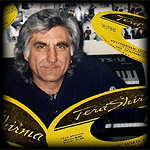Ralph....
What is 'EQ' ?
Why, and how was it used?
Results 1 to 14 of 14
-
07-31-2014, 04:14 AM #1
 Senior Member
Senior Member











- Join Date
- Aug 2010
- Posts
- 101,539
- Rep Power
- 1339
Ask Ralph : # 3 - What is 'EQ' - ?
-
07-31-2014, 07:51 AM #2
 Senior Member
Senior Member










- Join Date
- Aug 2010
- Posts
- 11,552
- Rep Power
- 296
Thank you, westgrandboulevard for starting these "alternative" threads. I can really get into this stuff, and Ralph has said he likes it too. Sure, they are very basic questions, but they work as starting points for those who are interested, and for just sparking a different type of discussion here.
It's a nice change from the same-'ol, same 'ol...if you know what I mean.
EQ: short for equalization. An equalizer is used for "equalizing", or adjusting frequencies in the audio spectrum.
There are two main types of equalizers used in the studio or home: parametric and graphic, with the parametric being most often used in mastering, for example. The one you use at home is more likely to be a graphic EQ. Even the tone controls on your stereo are a form of very crude EQ.
A Graphic EQ allows one to adjust each selected octave. A parametric EQ allows adjustments within each octave, while also allowing the adjustment of the width, among other fine adjustments without adversely affecting other octaves. Some EQ types allow one to make adjustments without introducing phase shifting.
If you use a DAW [[Digital Audio Workstation), such as a program in your computer, you can install any of a huge assortment of plug-in EQ, some with very sophisticated adjustments. For professionals, a large variety of EQ units can be employed, from vintage ones used in the snakepit, or custom units built by George Massenburg. Each pro EQ has a unique sound and are engineered to provide clean processing.
Oh, but you asked Ralph. I need to get some sleep!Last edited by soulster; 07-31-2014 at 09:29 AM. Reason: added content- OK, it's beddy-bye time!
-
07-31-2014, 08:18 AM #3
 Administrator
Administrator











- Join Date
- Aug 2010
- Posts
- 13,344
- Rep Power
- 100
Thank you for the assist, Soulster. Sleep tight.
-
07-31-2014, 04:52 PM #4thomas96 Guest
Ralph do you know if the guitarists and Jamerson/Babbitt did EQ on their individual instruments before recording, or could they not do it since they had the special DI box that Mike made? Adding on to that, was all the EQ done after finishing recording or would they record and listen to playback, then adjust the EQ and record again?
-
07-31-2014, 05:24 PM #5
 Senior Member
Senior Member










- Join Date
- Aug 2010
- Posts
- 11,552
- Rep Power
- 296
Generally, EQ is done during tracking and mixing.
-
07-31-2014, 05:34 PM #6
 Administrator
Administrator











- Join Date
- Aug 2010
- Posts
- 13,344
- Rep Power
- 100
Thomas,
I do remember my brother telling me how hard Jamerson's bass was to deal with at times during mixing. At times definition was a little lost due to the depth of his bass, I guess. whether messing with the EQ would help[[and this may have been applied) is hard to say. The bottom line is it worked.
-
07-31-2014, 05:37 PM #7
 Administrator
Administrator











- Join Date
- Aug 2010
- Posts
- 13,344
- Rep Power
- 100
To further answer your question, Thomas, the idea is to use as little EQ as possible. The ideal is flat recording to tape and then touch things up with EQ [[if needed) in the mix. These aren't hard fast rules but it was best to try and accomplish this as closely as possible.
-
07-31-2014, 08:37 PM #8thomas96 Guest
Thanks Ralph. Also, on another subject, could you try to explain how tracks were mastered?
-
07-31-2014, 08:38 PM #9thomas96 Guest
Like the process from multi-track tape to master lacquer.
-
07-31-2014, 08:50 PM #10
 Administrator
Administrator











- Join Date
- Aug 2010
- Posts
- 13,344
- Rep Power
- 100
Sure Thomas,
The mixed tape was sent to the disc lathe room where it was put into a recorder feeding the lathe. The engineer puts a blank disc on the turntable and sets the stylus and begins to run the song, meanwhile checking the grooves being made by the stylus being certain the no two grooves would come too close together, an indication of distortion. After playing around with it a while and getting things just right, the final disc is cut and then sprayed with a blast of nitrogen to assure no dust was on the disc and it was then sealed in a special plastic bag and sent to the record pressers. I forgot to mention that the groove placement is checked by a microscope attached to the lathe.
-
07-31-2014, 09:12 PM #11thomas96 Guest
The disc was made straight from the multi-track tapes, without a master tape being made and adjusting of amplitude throughout the track?
-
07-31-2014, 09:15 PM #12
 Senior Member
Senior Member










- Join Date
- Aug 2010
- Posts
- 11,552
- Rep Power
- 296
How records are cut. The process hasn't changed in decades:
-
07-31-2014, 09:16 PM #13
 Senior Member
Senior Member










- Join Date
- Aug 2010
- Posts
- 11,552
- Rep Power
- 296
Pt. 2
-
07-31-2014, 09:21 PM #14
 Senior Member
Senior Member










- Join Date
- Aug 2010
- Posts
- 11,552
- Rep Power
- 296
As for mastering a finished mix, there are whole books written on the subject. Here is the best out there:
http://www.soundonsound.com/sos/oct0...es/bobkatz.htm
http://www.amazon.com/dp/0240808371/...l_7qxwi1ry3o_b



 Reply With Quote
Reply With Quote


Bookmarks